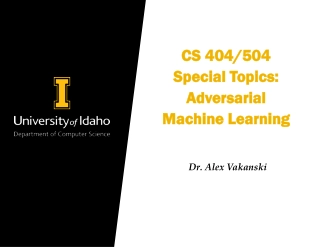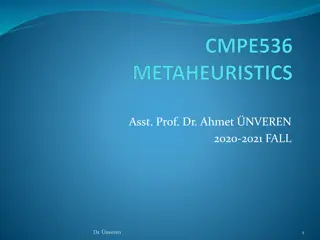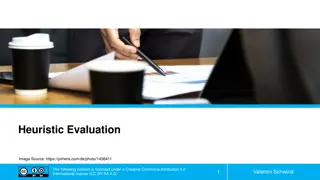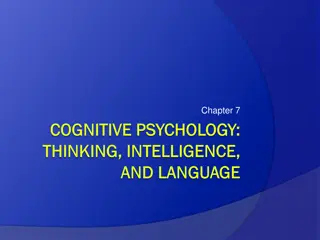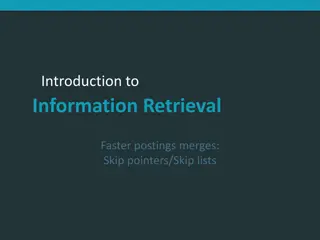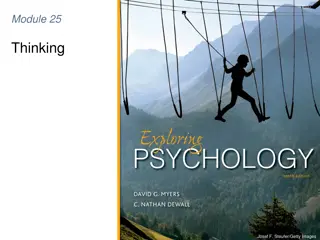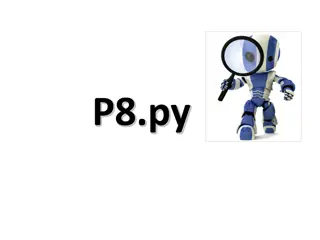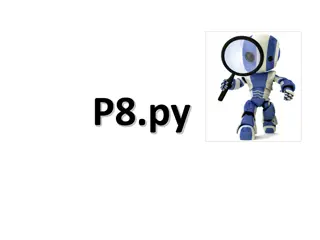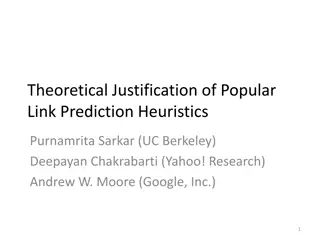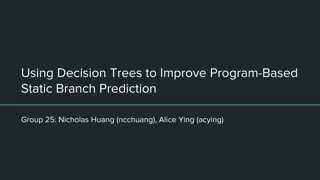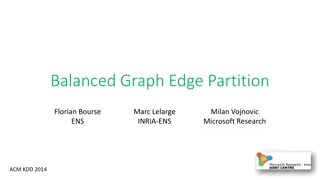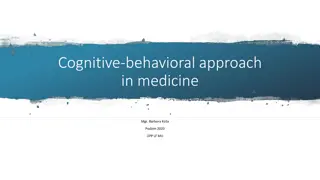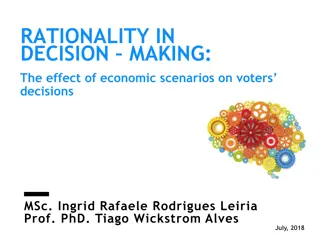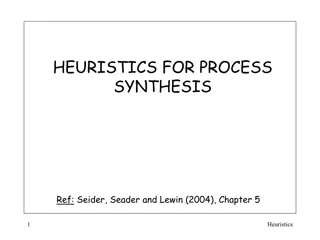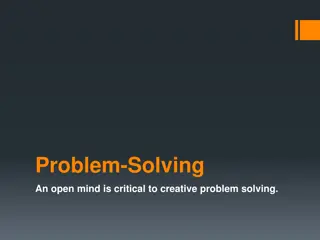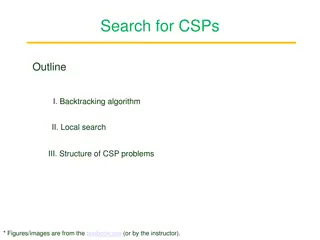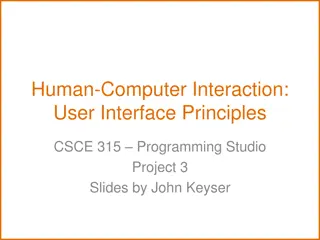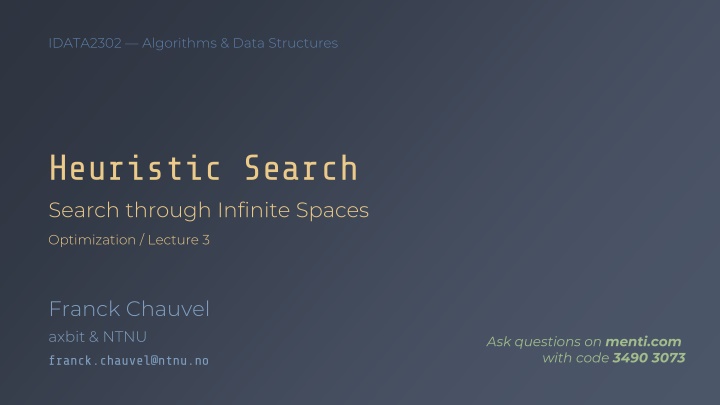
Optimization Techniques in Algorithms and Data Structures
Explore heuristic search and optimization through infinite spaces in IDATA2302 lecture by Franck Chauvel and axbit at NTNU. Dive into hard problems like TSP, SAT, and more, learning about random walks, simulated annealing, and knapsack problems. Understand solution landscapes, fitness landscapes, and multiple objectives in algorithmic optimization.
Download Presentation

Please find below an Image/Link to download the presentation.
The content on the website is provided AS IS for your information and personal use only. It may not be sold, licensed, or shared on other websites without obtaining consent from the author. If you encounter any issues during the download, it is possible that the publisher has removed the file from their server.
You are allowed to download the files provided on this website for personal or commercial use, subject to the condition that they are used lawfully. All files are the property of their respective owners.
The content on the website is provided AS IS for your information and personal use only. It may not be sold, licensed, or shared on other websites without obtaining consent from the author.
E N D
Presentation Transcript
IDATA2302 Algorithms & Data Structures Heuristic Search Search through Infinite Spaces Optimization / Lecture 3 Franck Chauvel axbit & NTNU Ask questions on menti.com with code 3490 3073 franck.chauvel@ntnu.no
Just too many Hard problems TSP, SAT, Clique, vertex cover, subsets, etc. A set of 100 elements has 1,26x 10^30 partition Total number of DNA pair on Earth (biomass) is 3.6 x 10^37 Infinitely many solution? Continuous domain
Agenda 1. Random Walks 2. Hill Climbing 3. Simulated Annealing 4. Tabu Search 3
Knapsack Problem 2 kg / 9 000 NOK laptop 7 kg / 3 000 NOK books 3 kg / 4 000 NOK music instruments 8 kg / 7 000 NOK cooking tools box (max 10 kg) 4
Neighbourhood {B, C, L} {C} -L +B What is a solution {C, L} What can we change? -C +M Constraint & Reachability {L} {C, L, M} 5
Solution Landscape {B, C} {B} {B, C, L} {B, L} {B, M} {B, C, M} {C} {B, C, L, M} {} {B, L, M} {L} {C, L} {M} {C, M} {C, L, M} {L, M} 6
Fitness Landscape 10 000 NOK {B, C} 15 kg 19 000 NOK 12 000 NOK 3 000 NOK {B} {B, C, L} {B, L} 7 kg 17 kg 9 kg 7 000 NOK 14 000 NOK 7 000 NOK {B, M} {B, C, M} {C} 23 000 NOK 0 NOK 8 kg 18 kg 10 kg {B, C, L, M} 20 kg {} 9 000 NOK 0 kg 16 000 NOK {B, L, M} {L} {C, L} 14 000 NOK 2 kg 10 kg 12 kg 4 000 NOK 20 000 NOK 11 000 NOK {M} {C, M} {C, L, M} 13 kg 3 kg 11 kg 13 000 NOK {L, M} 5 kg 7
Looking at NOK/kg Fitness Landscape ???????(?) =??????(?) {B, C} 666 ???? ?(?) 428 {B} {B, C, L} {B, L} 1 117 1333 {B, M} {B, C, M} 777 {C} 875 700 {B, C, L, M} {} 1150 1 600 4 500 {B, L, M} {L} {C, L} 1166 {M} {C, M} {C, L, M} 1538 1 333 1 000 {L, M} 2 600 8
Mutliple Objectives {B, C, L, M} 23 000 pareto front {C, L, M} 20 000 {B, C, L} 19 000 {C, L} 16 000 {B, L, M} {B, C, M} 14 000 13 000 {L, M} {B, L} 12 000 11 000 {C, M} 10 000 {B, C} {L} 9 000 {B, M} {C} 7 000 {M} 4 000 {B} 3 000 {} 0 19 0 2 3 5 7 8 9 10 11 15 17 18 20 12 13 9
How to find the optimal solution? when the problem is large or infinite 10
Random Walk We walk the solution space randomly Remembering the best solution we found. Stop when we are bored If we wait long enough, we are guaranteed to find the best solution 11
The Code Random Walk static Solution randomWalk(Problem problem, int limit) { var current = problem.simpleSolution(); var bestSoFar = current; for (int stepCount=0 ; stepCount < limit ; stepCount++) { current = problem.randomNeighbourOf(current); bestSoFar = problem.bestOf(bestSoFar, current); } return bestSoFar; } 12
Good Enough cheapest cost initial solution The optimal solution may not worth the time it takes to find it. sub optimal solution optimal solution time 13
How to find the optimal solution faster? 14
Hill Climbing N1 N6 Move to the fittest neighbour if it is increase the fitness N5 N2 S Steppest ascent N3 N4 15
The Code Hill Climbing static Solution hillClimbing(Problem problem, int limit) { var solution = problem.simpleSolution(); for (int stepCount=0 ; stepCount < limit ; stepCount++) { boolean noProgres = true; for (var eachNeighbour: problem.neighboursOf(solution) { solution = problem.bestOf(solution, eachNeighbour); noProgress &= solution != eachNeighbour; } if (noProgress) break; } return solution; } 16
Traps fitness Follow the slope Problem Local extrema plateau/shoulder ridges solutions 17
Hill Climbings Variants Stochastic Hill Climbing Pick a better neighbor at random Iterated Hill Climbing Rince and Repeat Gradient Descent Follow the derivative of the fitness function Beam Search best k-neighbours of k solutions 18
Simulated Annealing A way to 19
Annealing temperature crystallisation Metallurgy Change in hardness by heat and cooling down time ?1 ?2 ?3 ?4 20
Simulated Annealing temperature Unlikely accepted Very rarely accepted (time) Random walk + hill climbing Possibly accepted Unlikely accepted Pick a random neighbour Accept if better Roll a dice to accept bad one Very Likely accepted Possibly accepted Pr = ? ?/? Very bad Not too bad 21
The Code Simulated Annealing static Solution simulatedAnnealing(Problem problem, Schedule schedule) { var solution = problem.simpleSolution(); var time = 0; var temperature = schedule.temperatureAt(time); while (temperature != 0) { var candidate = problem.randomNeighbourOf(solution); var profit = problem.profit(solution, candidate); if (profit > 0 || random() < Math.exp(profit/temperature)) { solution = candidate; } temperature = schedule.temperature(++time); } return current; } 22
Takeaway Given an infinte time, simulated annealing will eventually find the global optima 23
Tabu Search What if we remember the past solutions 24
The Idea Tabu Search 0 0 2 4 Accept bad moves 0 2 2 3 pick the best neighbour Remember some past 0 3 1 0 Don t go back 0 2 1 0 25
The Code Tabu Search static Solution tabuSearch(Problem problem, int limit) { var tabu = new ArrayList<Solution>(); var current = problem.simpleSolution(); var best = current; tabu.add(current); for (int stepCount=0 ; stepCount<limit ; stepCount++) { current = problem.bestNeighbour(current, tabu); best = problem.bestOf(current, best); tabu.add(current); } } 26
Many More Algorithms Linear Programming Breaking Linear Equations PSO Particle Swarm Optimization Genetic Algorithms Mimic and evolution process Ant Colonny Mimic how ants find and exploit resources 27
Tackling Hard Problems Read solution and similar problems What neighborhood what fitness Select a set of problem instances Develop a simple/na ve solution Collect statistics Improve ORTools Z3 Depends on the problem SAT VRP etc. 28
Further Readings Artificial Intelligence: A Modern Approach by Peter Norvig and Stuart J. Russell 4th Edition 29
Thank You! Questions, Comments, or Ideas? Franck Chauvel Axbit & NTNU franck.chauvel@ntnu.no

